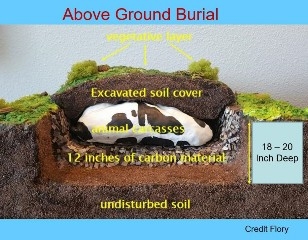Above Ground Burial An Overview of the Technology
ID
APSC-179NP
The challenges of limiting environmental, human health, and disease transmission risks of a highly contagious large animal disease such as Foot-and- Mouth Disease (FMD), African Swine Fever (ASF), or a non-disease related catastrophe is significant. Economic, human health, and environmental impacts from carcass disposal activities associated with foreign animal and zoonotic disease response pose catastrophic risks locally, nationally, and globally. For example, the economic impact of zoonotic epidemics from 1995 to 2008 exceeded $120 billion globally. This economic impact is not unique to the agricultural sector and leaves no individual, group, or sector of the economy unaffected.
Outbreaks in the United Kingdom in 2001, with Japan and South Korea in 2010, are clear reminders that carcass disposal is a critical component of an effective disease response strategy. Dramatic photos of cattle burning in open pyres during the 2001 FMD outbreak in the United Kingdom resulted in widespread public opposition to open burning. In South Korea, disease eradication efforts resulted in the destruction of 20% of the country’s livestock and the creation of 4,700 burial sites. This widespread carcass burial has resulted in concerns about massive environmental impacts associated with this activity.
In year 2015, the Virginia Cooperative Extension and the Virginia Department of Environmental Quality successfully field-tested Above Ground Burial (AGB) (see Figure 1. Above Ground Burial) on a farm in Rockingham County, Virginia. Our goal is to develop a technology for managing catastrophic livestock mortality that is simple to implement, is environmentally-sound, prevents the spread of disease, and is relatively economical. To date, there has been nine trials completed in the United States. Four of these projects were done in Virginia, with additional work being done in North Carolina, Texas, Oklahoma, and South Dakota.

Results of these trials are encouraging. The current Standard Operating Procedure as outlined in the VCE Publication (to be published) recommends implementation on a limited scale and in non-infectious disease situations. Additionally, the United States Department of Agriculture Animal Plant Health Inspection Service (APHIS) has developed a similar protocol for Above Ground Burial.
A summary of the results of the trials completed to date is shown below
- None of the field trials have experienced any noteworthy amount of bad odors emanating from the AGB burial sites.
- Only one of the field trials experienced any surface leachate (immediately, after installation, there was a real heavy rain event that caused a little leachate).
- Three of the sites experienced varmint digging (some of the sites were fenced). Overall the varmint digging was not excessive. We believe the varmint digging can be controlled and will not be a limiting factor.
- There have been three research projects completed to evaluate pathogen destruction. The studies evaluated decomposition of Clostridium perfringens, Swine Pox Virus and Seneca Valley Virus, respectively. All three of these research projects showed good pathogen destruction. There was one random sample from a poorly decomposed carcass that tested positive for clostridium perfringens.
- A general goal has been to have a system that achieved 80-90% carcass decomposition by the end of one year. Two of the Virginia Field Trials did not achieve this target with most of the other trials showing better results. The last field trial that we completed in Virginia clearly achieved this goal.
- Four of the field trials showed elevated concentrations of ammonium 36 inches beneath the bottom of the AGB trench.
- Four of the field trials showed no elevated soil nitrate levels beneath the carcasses. We believe that nitrification is not being achieved.
Additional research areas needed
- The elevated ammonium concentration in the subsoil beneath the carcass needs to be better evaluated to determine if it will be an environmental problem. Potentially, technologies need to be incorporated to prevent groundwater contamination.
- Additional research is needed to determine if there is specific types of carbon, additives, or other changes to the protocol that result in more consistently achieving 80 to 90% decomposition within one year in multiple settings.
- The current protocol recommends a maximum depth of 18-20 inches. We tried slightly deeper depths and achieved poor decomposition. We are having great debate regarding the proper depth.
- There is a theory that large amounts of fat inhibit decomposition. This needs to be better understood.
- Three studies show positive results for pathogen destruction but inevitably there will be a need for additional research to determine the fate of other types of pathogens in the AGB environment.
Technical Resources
Bobby Clark, Virginia Cooperative Extension, raclark@vt.edu, 540-459-6140 or 540-333-3227.
Mark Estienne, Virginia Tech Tidewater Agriculture Research Center, mestienn@vt.edu.
Gary Flory, Virginia Department of Environmental Quality, gary.flory@deq.virginia.gov, 540-820-0934.
Bob Peer, Virginia Department of Environmental Quality, robert.peer@deq.virginia.gov, 540-325-2370.
Virginia Cooperative Extension materials are available for public use, reprint, or citation without further permission, provided the use includes credit to the author and to Virginia Cooperative Extension, Virginia Tech, and Virginia State University.
Virginia Cooperative Extension is a partnership of Virginia Tech, Virginia State University, the U.S. Department of Agriculture (USDA), and local governments, and is an equal opportunity employer. For the full non-discrimination statement, please visit ext.vt.edu/accessibility.
Publication Date
June 28, 2021



